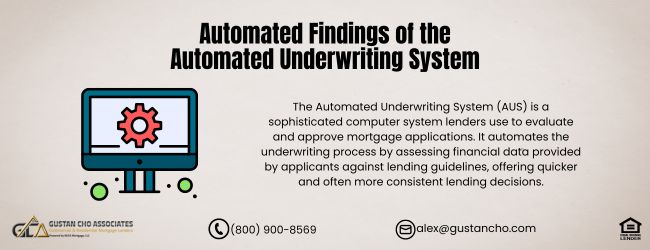Automated Findings of the Automated Underwriting System

This guide covers the Automated Findings of the Automated Underwriting System (AUS). The Automated Underwriting System (often referred to AUS) is an intricate sophisticated computer system. Loan officers enter borrower’s data to the automated underwriting system. Within seconds, the automated underwriting system (AUS) will analyze the borrowers’ credit report, credit scores, employment history, credit payment history, public records, asset/income data and render Automated Findings. Data Collection: The system gathers information from the mortgage application, including credit scores, employment history, income, assets, and liabilities.
The collected data is compared against the lender’s specific underwriting guidelines or those of government-sponsored entities like Fannie Mae or Freddie Mac.
An Automated Underwriting System (AUS) is a technology-driven platform lenders use to evaluate and approve mortgage applications. It automates the underwriting process by assessing the financial data provided by applicants against lending guidelines, offering quicker and often more consistent lending decisions. Based on the comparison, the system calculates the application’s risk level and assigns a risk score or recommendation. In the following paragraphs, we will cover an overview of how the automated underwriting system works:
Automated Underwriting System Decision Making
The AUS provides a preliminary decision such as approve/eligible, approve/ineligible, or refer/manual underwrite. The decision informs whether the application will likely meet lending standards or requires further human review. Automation makes the underwriting process faster and more efficient. This is particularly beneficial for high-volume lenders and offers applicants quicker feedback. Two common AUS systems used in the mortgage industry are Fannie Mae’s Desktop Underwriter (DU) and Freddie Mac’s Loan Product Advisor (LPA).
Benefits of Automated Underwriting System
Decisions are based on standardized rules, reducing variability in the underwriting process. The automated underwriting system speeds up the loan approval process compared to manual underwriting. The AUS identifies risk factors accurately and consistently, helping lenders make informed decisions. While Automated Underwriting Systems improve efficiency and accuracy, final approval often still requires a review by a human underwriter to verify specific data or address unique aspects of the application.
Qualify for home loan with our expert
What Are The Findings of the Automated Underwriting System
The Automated Underwriting System has specific algorithms in rendering the following the Automated Findings:
- Approve/Eligible which means an automated approval
- Refer/Eligible which means the AUS cannot render an Automated Findings Approval
- but the file can be downgraded to a manual underwrite
- Refer/With Caution which means the borrower does not meet Agency Mortgage Guidelines. For example, with FHA loans, refer with caution means the file does not meet HUD guidelines per HUD 4000.1 FHA Handbook
In this article, we will cover and discuss FHA Automated Findings On Automated Underwriting System (AUS).
Agency Mortgage Guidelines Versus Lender Overlays
GCA Mortgage Group is different than other lenders due to its no lender overlays policy on government and conventional loans. We do not have any lender overlays on FHA, VA, USDA, Conventional loans. We just go off the automated findings of the Automated Underwriting System (AUS).
If borrowers get an approve/eligible per AUS and can meet all the conditions of the AUS, the borrower can rest assured that we will not just close the loan but will close it on time. Very rarely do we have delays on any borrower’s home loans.
All lenders need to have their borrowers meet the minimum agency mortgage guidelines which are determined by the AUS. Lenders can have additional guidelines that are above and beyond of the AUS which are called lender overlays. Example of lender overlays includes higher credit scores, lower debt to income ratio, outstanding collections being paid off, manual underwriting, and other higher-income and credit standards. GCA Mortgage Group has no lender overlays on government and conforming loans.
How The Automated Underwriting System Works
The loan officer will submit all pertinent data of the borrower in the automated underwriting system. The AUS will analyze and render its decision within a matter of seconds. As long as the borrower meets all agency guidelines, the AUS will render an approve/eligible per AUS. Lenders with no overlays will only go by the AUS Findings. However, most lenders have lender overlays which means that lender has additional lending guidelines besides of the minimum agency guidelines rendered with AUS Approval. Borrowers with prior bad credit, lower credit scores, and outstanding collections should seek the consultation of a direct lender with no overlays like GCA Mortgage Group. Talk to our expert for loan with low credit
HUD Guidelines Versus Typical Common Lender Overlays
In this paragraph, we will go over the minimum HUD Lending Mortgage Guidelines versus common lender overlays imposed by many lenders: HUD requires a 580 credit score to qualify for a 3.5% down payment home purchase FHA loan: Most Lenders require a 620 to 640 credit score as part of their lender overlays. HUD allows borrowers under 580 credit scores and down to 500 FICO with 10% down payment:. Most lenders will not touch any borrowers under 580 FICO. HUD does not require borrowers to pay off outstanding collections and charged-off accounts. Most lenders will require outstanding collections and/or charged-off account in order for borrowers to qualify for FHA loans. HUD does allow late payments in the past 12 months by borrowers if they can get an approve/eligible per AUS. Many lenders will not allow late payments in the past 24 months even with an approve/eligible per AUS.
Manual Underwriting
On refer/eligible findings on the AUS, VA and FHA loans allow for manual underwriting. VA and HUD allows manual underwriting on VA and FHA loans. Many lenders will not accept manual underwriting. Borrowers can qualify for VA and FHA loans during Chapter 13 Bankruptcy Repayment Plan with Trustee Approval after the consumer makes 12 timely payments to the courts via manual underwriting. Most lenders will not accept any borrowers who are in a current active Chapter 13 Bankruptcy Repayment plan. There is no waiting period after Chapter 13 Bankruptcy discharged date to qualify for VA and FHA loans. Most lenders will require a two-year waiting period after Chapter 13 Bankruptcy discharged date as part of their lender overlays. For more information about the content in this article or other mortgage-related topics, please contact us at Gustan Cho Associates Mortgage Group at 800-900-8569 or text us for a faster response. Or email us at gcho@gustancho.com.
FAQs: Automated Findings of the Automated Underwriting System
- What is the Automated Underwriting System (AUS)? The Automated Underwriting System (AUS) is a sophisticated computer system lenders use to evaluate and approve mortgage applications. It automates the underwriting process by assessing financial data provided by applicants against lending guidelines, offering quicker and often more consistent lending decisions.
- How does the AUS work? Loan officers enter the borrower’s data into the AUS, which analyzes the information, including credit scores, employment history, income, assets, and liabilities. The system compares this data against the lender’s specific underwriting guidelines or those of government-sponsored entities like Fannie Mae or Freddie Mac.
- What are the types of decisions made by the AUS? The AUS can render several preliminary decisions, including Approve/Eligible, an automated approval indicating the application meets lending standards. Refer/Eligible means the AUS cannot provide an automated approval, and the file may be downgraded to manual underwriting. Lastly, Refer/With Caution indicates the borrower does not meet Agency Mortgage Guidelines, such as those outlined in HUD guidelines for FHA loans.
- What are the benefits of using an AUS? Standardization in the underwriting process is achieved by basing decisions on standardized rules, which reduces variability. The Automated Underwriting System (AUS) speeds up the loan approval process compared to manual underwriting. Furthermore, the system is designed to identify risk factors accurately and consistently, aiding lenders in making informed decisions.
- What are lender overlays? Lender overlays are additional guidelines that some lenders apply on top of the minimum agency mortgage guidelines determined by the AUS. These can include higher credit score requirements, lower debt-to-income ratios, and the need to pay off outstanding collections.
- What are some common lender overlays compared to HUD guidelines? HUD mandates a minimum credit score of 580 to be eligible for a 3.5% down payment FHA loan. However, numerous lenders prefer 620 to 640. HUD does not require paying off outstanding collections, but many lenders do. Additionally, if approved by the AUS, HUD has allowed late payments in the past 12 months, while many lenders have not allowed late payments in the past 24 months.
- What is manual underwriting, and when is it used? Manual underwriting is used when the AUS renders a refer/eligible decision. It involves a human underwriter reviewing the application. VA and FHA loans allow for manual underwriting, including for borrowers in a Chapter 13 Bankruptcy Repayment Plan with trustee approval after 12 timely payments.
- How can I qualify for a home loan with no lender overlays? GCA Mortgage Group has a no-lender overlays policy on government and conventional loans. Suppose the AUS renders an approved/eligible decision and all conditions are met. In that case, GCA Mortgage Group will close the loan on time without additional overlays.
- Where can I get more information? For more information about the AUS or other mortgage-related topics, contact Gustan Cho Associates Mortgage Group at 800-900-8569, text for a faster response, or email gcho@gustancho.com.







Responses